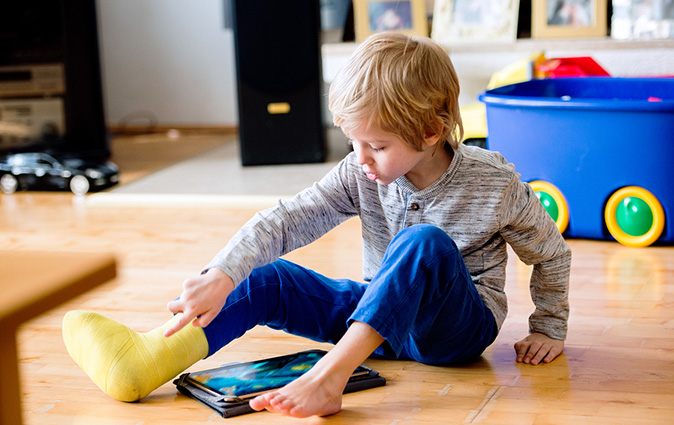Leg and Knee Injuries and Conditions in Children

Common leg and knee conditions in children include overuse injuries, Osgood-Schlatter disease, fractures of the femur, tibia or tibial spine, and deformities like knock knees or bowlegs. Less often, but frequently treated at HSS, some children experience a leg length discrepancy caused by a leg fracture that affects the growth plate or by a disease or other condition. Below is an overview followed by links to longer pages on various conditions.
Fractures
Childhood fractures are common. Prompt diagnosis and treatment are essential. There’s only a narrow window of time to make sure the bone is in the best position to heal correctly and to determine whether the child's growth plate has been affected. Pediatric orthopedic surgeons are the best doctors to diagnose and treat a childhood fracture. A problem HSS pediatric orthopedic surgeons encounter frequently is a child who was previously brought to an orthopedic surgeon who generally treats adults and who may or may not understand the nuances of childhood fractures.
The good news is that with prompt and appropriate treatment by a specialist, most childhood fractures heal well without complications.
Knock knees and bowlegs
If you’re concerned that your young child has knock knees or bowlegs, know that many kids don’t have perfectly straight legs, and this is usually a normal part of growth. Babies are born bowlegged, but by 18 months, their legs straighten. From 18 months to age three or four, most kids’ legs appear knock-kneed, which is also normal. It’s common for kids to look bowlegged when they start walking, and this typically lasts until around age two. Normal leg alignment develops by age five to seven, though some variation is still normal.
When to see a pediatric orthopedic surgeon about a child's knee alignment
Parents often wonder if they should see a specialist for their child. Pediatric orthopedic surgeons specialize in childhood bone growth and development. Many parents just need reassurance, and it’s okay to seek a second opinion. If there’s an alignment issue, early diagnosis is crucial for effective treatment.
While poor leg alignment often resolves on its own, treatment may be necessary. Sometimes, follow-up visits over several months are needed to monitor growth. X-rays and blood tests might be ordered to rule out underlying conditions. Early diagnosis and treatment are always beneficial.
Parents should see a specialist if a child has a severe bowleg deformity worsening by age two, knock knees persisting at age nine, or if the child is limping or in pain.
Why treatment is important
Minimally invasive treatments for mild to moderate knock knee or bowleg deformities are effective, especially if addressed early. If a child with severe bowlegs is older than five or six, bracing or minimally invasive techniques may no longer be an option, and more substantial orthopedic surgery might be required.
If the deformity is severe or the child is too old for bracing or a minimally invasive procedure, major surgery may be needed in which we straighten the bone, with recovery taking two to three months.
Difference in leg length
Leg length discrepancy, though less common than bowlegs or knock knees, is another condition pediatric orthopedic surgeons treat. It can be congenital or result from infection, arthritis, or injury. Even a well-treated fracture can cause one leg to be shorter due to growth plate involvement.
Minor leg length differences are common and usually harmless, but when the gap approaches an inch or more, it can affect balance, gait, and lead to pain in the lower back, knees, or hips. Pediatric orthopedic surgeons offer treatments to equalize leg length, focusing on the difference by the time the child finishes growing.
Limb lengthening: Advances in treating leg length discrepancy
When a youngster has one leg that’s shorter than the other, a number of treatment limb lengthening options are available. The latest advance is a magnetic lengthening rod that is implanted into the shorter bone. An external magnet is placed on the child’s leg several times a day to lengthen the rod a tiny bit at a time. This enables the bone to get longer and longer, until the short leg catches up to the longer leg and they are both the same length.
More on childhood leg and knee conditions
Visit the links below to read about various pediatric knee and leg conditions, and the treatments available.
- Benign Bone Tumor
- Bone Lesion
- Bowlegs
- Cartilage Injuries & Disorders
- Compartment Syndrome
- Compound Fracture
- Growing Pains
- Growth Plate Fracture
- Knock Knee
- Metastatic Bone Disease
- Muscle Injuries and Disorders
- Neurofibromatosis
- Osgood-Schlatter Disease
- Osteosarcoma (Bone Cancer)
- Shin Splints
- Soft-Tissue Sarcoma
- Tendinosis
- Tendon Injuries and Conditions
Overview articles
- Adolescent Anterior Knee Pain: A Brief Overview
- Blount's Disease: An Overview
- Bowlegs and Normal Growth and Development of the Legs and Knees
- Cerebral Palsy: Surgery and Nonsurgical Orthopedic Treatments
- Femur Fractures in Children: Treating a Child’s Broken Thighbone
- Gait Analysis at HSS Motion Analysis Lab
- Helping Gymnasts Recover from Injuries
- Inflammatory Arthritis in Children: More than Growing Pains
- Legg-Calve-Perthes Disease: An Overview
- Limb (Leg) Deformity Reconstruction for the Pediatric Patient
- Limb Lengthening – An Overview
- Orthopedic Complications of Neurofibromatosis Type 1: Scoliosis, Tibial Dysplasia and Other Issues
- Pediatric Limb Lengthening: Corrective Surgery for Leg Length Discrepancy in Children
- Pediatric Sports Injuries: An Overview
- Tibial Pseudarthrosis: Incorrect Healing After a Pediatric Fracture of the Lower Leg
- Tibial Spine Fractures in Children: What to Know
Leg and Knee Injuries and Conditions in Children Success Stories

